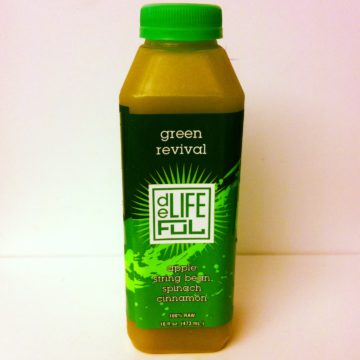 Chances are you’ve noticed that fruits and vegetables have taken on new shapes, colors, combinations, and flavors thanks to the latest diet trend, juicing. With specialty juice bars on every corner, and celebrities and scientists weighing in on the health benefits of trading your bite of a mere apple for a slurp of a super-charged apple-kale-ginger concoction, it’s hard to resist not taking your produce for a whirl and a chop in a blender near you. But how much of this phenomenon is the hype of novelty, and how much should be taken seriously? Before trading in your silverware for an economy-sized box of bendy straws, consider these pros and cons that will affect your waistline and your wallet.
Chances are you’ve noticed that fruits and vegetables have taken on new shapes, colors, combinations, and flavors thanks to the latest diet trend, juicing. With specialty juice bars on every corner, and celebrities and scientists weighing in on the health benefits of trading your bite of a mere apple for a slurp of a super-charged apple-kale-ginger concoction, it’s hard to resist not taking your produce for a whirl and a chop in a blender near you. But how much of this phenomenon is the hype of novelty, and how much should be taken seriously? Before trading in your silverware for an economy-sized box of bendy straws, consider these pros and cons that will affect your waistline and your wallet.
Pros:
– Juice provides many of the same essential vitamins and nutrients as whole fruits and vegetables. The liquid form can also give your digestive system a break from digesting tough fiber, allowing for a more seamless absorption of nutrients into the bloodstream.
– Popular juicing ingredients—like beets and dark berries—are known as super foods and retain their super-powers even in a cup. One to two cups of juice a day has been said to increase blood flow, decrease blood pressure, boost the immune system, and deliver antioxidants and nitrates that are key components to good, balanced health.
– Kids are not the only ones who’d opt for bowl of ice cream over a bowl of broccoli: adults can also have trouble fitting adequate amounts of fruits and veggies into their diet. And with today’s busy lifestyle, unwrapping a candy bar is often more convenient than unpeeling an orange. Enter juice: a fun and easy way to make produce a one-handed, grab-and-go food you can drink on the bus, in the car, walking down the street, and at your desk all with ease. Juice can introduce you to a variety of produce you might not have access to or are intimidated to make via traditional preparations—such as kale—and there’s an infinite array of combinations and recipes to suit any palate. Add-ins like almond milk, yogurt, flax, and nut butters can also make up for nutritional deficiencies of straight juice, rendering it a more complete meal. Refreshing green mixes (I love anything with apples, mint, and spinach) can be a great addition to lunch when colder weather sets in, and dessert-types can feel satisfied but not guilty for indulging in a peanut butter-and-blueberry treat.
I tried It: 3 day Juice Cleanse
Cons:
– On its own, juice often lacks the most healthful parts of the food itself. Nutrients and filling fiber resides in the skin, and while you can preserve some fiber by drinking juice with pulp it’s not quite the same because the food’s already been processed: your body is not breaking it down on its own, thereby slowing your metabolism. There’s also no hard scientific evidence that the above mentioned benefits of juice are true: most likely, all the good stuff is inherent in a plant-based diet like veganism.
– Brace yourselves, if you’ve been wanting to detox à la Beyoncé: Like many fad diets, all liquid diet is not a sustainable weight-loss method. Restricting calories during meals, and especially restricting fiber intake, can induce binge eating that ruins the healthiness of the juice you nursed all day. The lack of protein in juice can lead to decreased muscle mass, which is important for maintaining a healthy weight. Cleanse diets in general will also slow your metabolism, so after resuming a diet of chewable foods your body will make fat cells more quickly, leading to weight gain rather than loss.
– Think organic whole fruits and vegetables are expensive? Juice is just as pricey, and since it’s an incomplete meal by itself you’ll end up spending more on one serving of juice than a plate (or several) of solid food. For the DIY juicers, appliances run anywhere between $50 and $400; each stop at a juice bar can cost around $10. At Juice Generation, an expanding and popular juice chain in New York City, a 12 oz. juice costs $7.95 and would cover just one meal or snack; the equivalent in whole food—about three medium pieces of fruit—would only cost about $2 and be part of three separate meals.
– Servings, calories, and sugar all add up fast. One medium piece of fruit (60 calories), 1 cup of vegetables (25 calories) or 3 cups of leafy green vegetables (25 calories) all come out to about 4 oz. of juice: that means your 12 oz. cup gives you three servings in one sitting, and three times the calories. While they’re not artificial like those in sugary beverages, the calories in juice are just as empty in a way given the high proportion of sugar to protein and healthy fats. At Juice Generation, you might be swayed to think the Citrus Super C juice is a quick and easy defense mechanism from colds: but in 12 oz. you’ll get 160 calories and 32 grams of sugar, the same amount of sugar as a grande (16 oz.) Caramel Macchiato at Starbucks. The Protein Buzz smoothie may sound like the perfect boost to your workout, but its 24 oz. deliver an unwanted punch: 410 calories with 56 grams of sugar and only 18 grams of protein; a Berry Freeze Blitz Slurpee of the same size has 192 calories and 51 grams of sugar.
The Verdict: Like all things, juice is best when taken in moderation. An interesting new blend is a great substitute for a tired Clif bar, but these all-natural foods are best taken the way nature made them, no blender required.
More by Jennifer: Eco Chic- Living Sustainably Inside and Out
Photo: Peaceful Dumpling
__
Jennifer Kurdyla crossed the river from New Jersey into Manhattan two years ago. She has maintained a vegetarian lifestyle for six years and would love to move to the Mediterranean for more of an excuse to eat the divine meat-less cuisine on a regular basis. An experienced yogi and former dancer, she is an advocate for finding balance in all areas of life. Follow Jennifer on Pinterest.




